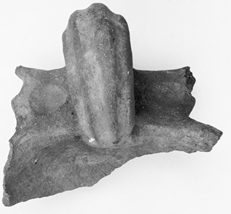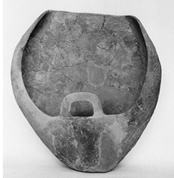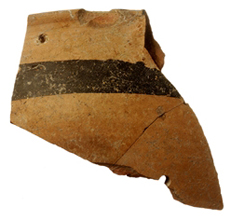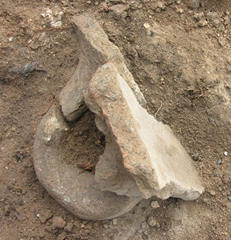Bronze age : vessels
Ceramic vessels of the late bronze Age
.jpg)
 Most of the ceramic vessels of the Late Bronze Age have the same technical characteristics as those of the Early Bronze Age. They are handmade, fired at moderate temperatures, and use the same kinds of clays. Moreover, the range of shapes is very similar: jars with applied coils decorated with finger impressions or notches are very close morphologically to those of the EBA, although larger in size. Jugs with cut-away necks also continue to exist. At the same time, new vessel types emerge, such as double vessels with a basket-handle in the centre, and a unique large open basin-like vessel (opening of about 60 cm), with an inturned rim and one horizontal handle. The most characteristic smaller vessels are spherical bowls with angular vertical handles raised above the rim (“kantharos” shaped) and open bowls with crescent-like handles.
Most of the ceramic vessels of the Late Bronze Age have the same technical characteristics as those of the Early Bronze Age. They are handmade, fired at moderate temperatures, and use the same kinds of clays. Moreover, the range of shapes is very similar: jars with applied coils decorated with finger impressions or notches are very close morphologically to those of the EBA, although larger in size. Jugs with cut-away necks also continue to exist. At the same time, new vessel types emerge, such as double vessels with a basket-handle in the centre, and a unique large open basin-like vessel (opening of about 60 cm), with an inturned rim and one horizontal handle. The most characteristic smaller vessels are spherical bowls with angular vertical handles raised above the rim (“kantharos” shaped) and open bowls with crescent-like handles.

 A large number of vessels, especially those that are kantharos-shaped, have a graphite-coating on the exterior surface which is often difficult to distinguish from ceramic fabrics rich in mica. This is part of a complex decoration technique, combining incision, graphite coating, and addition of a coloring material after firing, which is characteristic of the Late Bronze Age in the region. The most common patterns are spirals and rectilinear bands, together with triangles and circles displayed in a rectangular frame.
A large number of vessels, especially those that are kantharos-shaped, have a graphite-coating on the exterior surface which is often difficult to distinguish from ceramic fabrics rich in mica. This is part of a complex decoration technique, combining incision, graphite coating, and addition of a coloring material after firing, which is characteristic of the Late Bronze Age in the region. The most common patterns are spirals and rectilinear bands, together with triangles and circles displayed in a rectangular frame.
 The 2008 excavation recovered the first three — and so far the only — fragments of Mycenaean-type vessels in the settlement. One is from a bowl (“skyphos”) characteristic of the Late Helladic III C period. We do not yet know whether these vessels were imported or locally produced. Their manufacturing technique, however, is totally different from the rest of the ceramic production: they are wheel-made, use a very fine clear-colored clay, and are decorated with a lustrous dark brown paint. They were probably fired at high temperatures (≥ 850-900°C), which gave them a quite distinctive texture and a clinging sound.
The 2008 excavation recovered the first three — and so far the only — fragments of Mycenaean-type vessels in the settlement. One is from a bowl (“skyphos”) characteristic of the Late Helladic III C period. We do not yet know whether these vessels were imported or locally produced. Their manufacturing technique, however, is totally different from the rest of the ceramic production: they are wheel-made, use a very fine clear-colored clay, and are decorated with a lustrous dark brown paint. They were probably fired at high temperatures (≥ 850-900°C), which gave them a quite distinctive texture and a clinging sound.
Very few vessels have been found in contexts that tell us much about their functions, or at least their final use. The case of a jar that was found broken on a floor is almost exemplary: around it there were many charred grape seeds, while the vessel itself seems to be impregnated with a residue whose analysis is in progress. It may be that this jar was used for the fermentation of pressed grapes, perhaps perpetuating a practice started at Dikili Tash as early as the Late Neolithic II.

